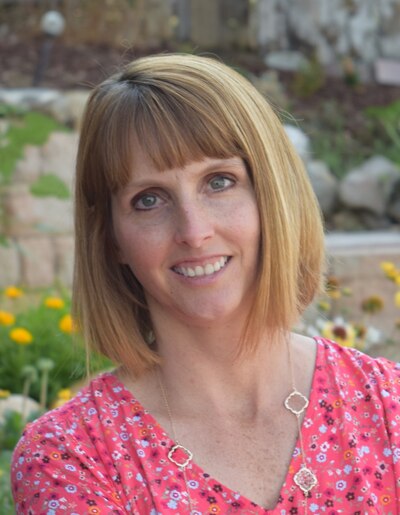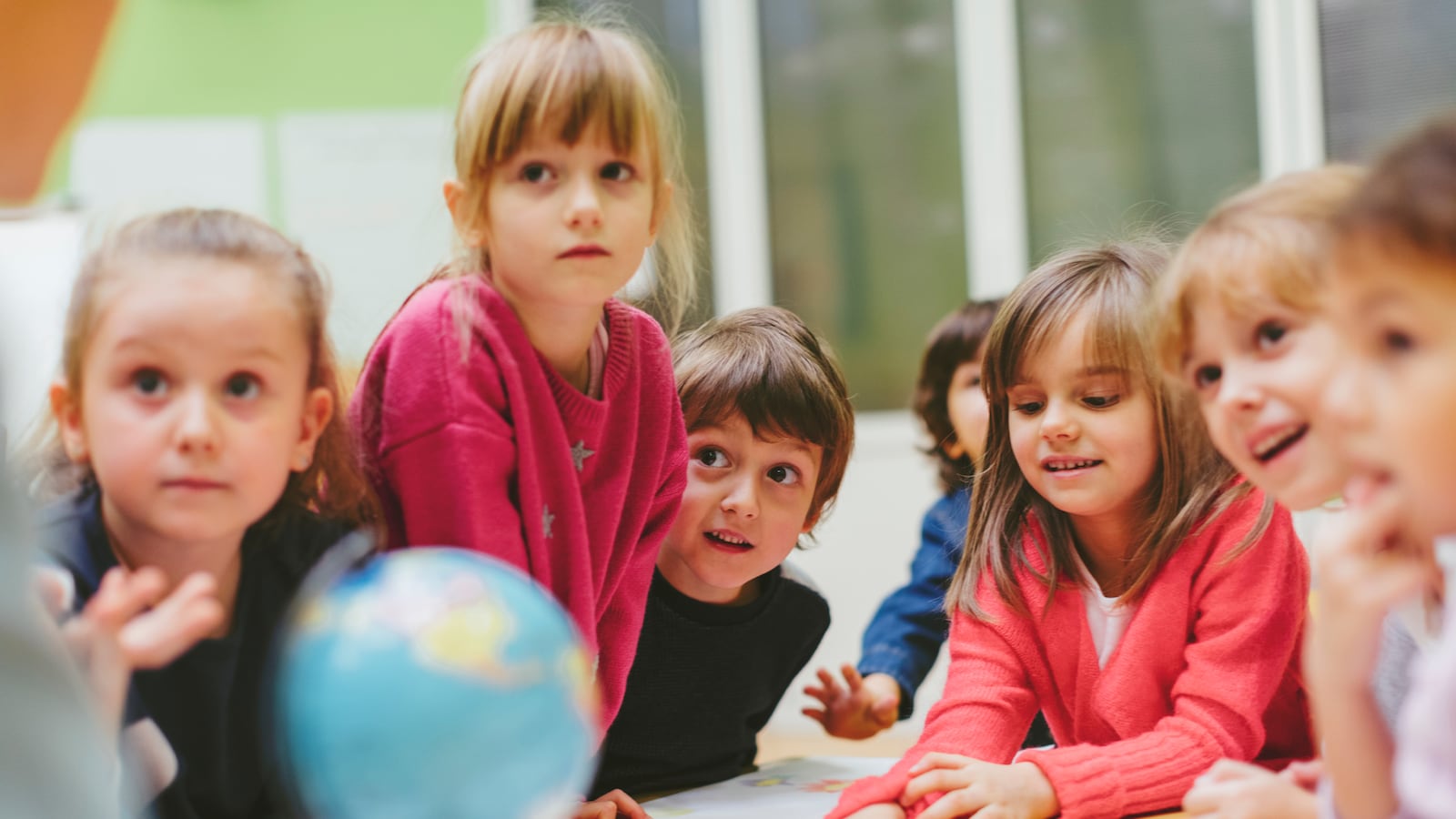Here, in a feature we call How I Teach, we ask educators who’ve been recognized for their work how they approach their jobs. You can see other pieces in the series here.
Amy Jones’ favorite lesson will make you want to be in kindergarten again. After decorating paper dolls, the youngsters in her class at Sunset Elementary School in the western Colorado city of Craig send them to countries around the world and follow their adventures on Twitter for a week.
The annual project teaches her students, many of whom have never traveled far from home, about the culture of countries such as India, Australia and Germany.
“Kindergarteners are capable of rich and authentic learning,” said Jones, one of six finalists for the 2019 Colorado Teacher of the Year award.
“If we can teach children to respect the differences and celebrate the similarities of people around the world at a young age, maybe we will have a more peaceful future.”
Jones talked to Chalkbeat about how her project brings abstract concepts to life, why she loves technology, and how she brings storytime into her students’ homes.
This interview has been condensed and lightly edited.
Was there a moment when you decided to become a teacher?
The moment I knew I wanted to be a teacher was probably in high school. I volunteered in a kindergarten classroom a couple days a week and fell in love with the energy, imagination, curiosity, exploration, discovery and creativity of 5- and 6-year-olds.

This volunteer experience helped me reflect on my amazing first-grade teacher. I moved from West Virginia to Florida that year and the standards in Florida were much more rigorous than they had been in West Virginia. With the rest of the class already reading, I cried going to school every day knowing how far behind I was.
When my parents finally realized the problem, I changed schools and was placed with an amazing teacher who took extra time helping me learn to read. She spent lunches with me and sent books home for practice each night. She encouraged, nurtured and worked with me, and with the extra support I received, I was reading in no time. I wanted to have the same impact on the life of a young student.
How do you get to know your students?
I take the time each day to personally check in with each student and have conversations with them about their interests inside and outside of school. I let them know how much I care about them and establish clear boundaries. It’s these strong connections that keep former students visiting my classroom and sending me graduation announcements and wedding invitations once they have graduated.
Tell us about a favorite lesson to teach. Where did the idea come from?
My favorite lesson to teach connects my students to other students globally. In Craig, a rural community of about 9,000 people, many young students have not traveled further than Grand Junction, 150 miles away. Kindergarteners are expected to compare and contrast how people live in different settings around the world; give examples of food, clothing, and shelter in various environments; and understand the difference between a globe and a map. This is a very abstract concept for concrete learners.
I brainstormed with another teacher in my school with global connections and adapted a lesson from the Flat Stanley Project, which links classrooms in different countries. Using social media platforms to connect with schools worldwide, I collaborated with teachers in India and the North Pole (the previous year Hong Kong, Australia, and Germany were involved). Each classroom created a Flat Stanley-like paper doll to represent the area in which they lived and chose a “portal” to transport their class doll to another part of the world.
After choosing the globe to be our portal, my students went home and the magic began. That evening, I scanned our paper doll and emailed it to the other teachers, as they did for us. After receiving an email with the scanned Indian and North Pole paper dolls, I printed and cut out their creations, placing them back on the portal.
The next morning, the students were amazed to see two paper dolls dressed in native clothing from our Indian and North Pole friends and our paper doll gone. Using #flatstanleyportal on Twitter, we discovered our Stanley had cloned himself and landed in the classrooms of India and Alaska. The week was spent tracking our Stanleys on Twitter, in the classrooms and homes of students while showing each other the food eaten, clothing worn, and different shelters inhabited.
After a week, the Stanleys were left on the portal at the end of the school day and the next morning their original Stanley was back home in their native classroom. Kindergarteners are capable of rich and authentic learning. If we can teach children to respect the differences and celebrate the similarities of people around the world at a young age, maybe we will have a more peaceful future.
What object would you be helpless without during the school day?
My computer and smart board. Technology helps us bridge connections with students and teachers worldwide, and allows learning to extend outside of our school walls. It allows my students to gather background knowledge and take virtual field trips. It allows for our partner classes in Hong Kong, Beirut, Croatia and Canada to connect on Twitter weekly to share our learning. It allows me to connect with other teachers to share ideas and pedagogy, and communicate with families through our class website and newsletters home.
What’s something happening in the community that affects what goes on inside your class?
When I taught in Denver, each school had a great amount of support staff, including gifted-and-talented teachers, resource teachers, special education teachers, and psychologists/counselors.
Moving to a smaller rural community was an eye opener! In Craig, every school includes students from low- to high-income families, special-needs students, students with challenging behavior, gifted students and English learners.
Our resources, however, do not match these needs. We have one gifted-and-talented teacher and one psychologist for five schools. We have one teacher who manages the special education plans for most special-needs students.
We have a huge teacher shortage, with many teachers on emergency teaching licenses. We also have a very difficult time filling paraprofessional positions and finding substitute teachers.
With all of these issues, teachers must differentiate for all students, must be skilled at dealing with greater emotional needs within the classroom, must learn to successfully teach English learners, and must be supportive of all socioeconomic levels.
Tell us about a memorable time — good or bad — when contact with a student’s family changed your perspective or approach.
I have been an advocate for educating parents on the importance of reading aloud to your child, no matter their age. The librarian and I decided to implement a Sunday Night Read Aloud where teachers at our school take turns recording themselves reading a story at their home.
These videos are put on our school Facebook page on Sunday evenings so kids can get in their pajamas and listen to a teacher read to them before bed. Originally, I planned to do this once or twice, but I had a family let me know how much they enjoyed listening to the story I read multiple times and ask me to record a book every week.
I decided I needed to practice what I preached and recently began a new routine of recording a weekly story and sending it to my kindergartener families. Not only do I get to visit my students digitally in the comfort of their home, but I am modeling for adults engaging ways to read a story.
What part of your job is most difficult?
The most difficult part of my job is addressing the emotional needs of students. We have children coming from homes with substance abuse and neglect, dual working parents with unconventional hours, and many grandparents are now raising our students. As educators, we can’t solve the root causes of this problem, but we can take an active role in offsetting it through strong relationships.
What was your biggest misconception that you initially brought to teaching?
The biggest misconception I initially brought to teaching is that everyone needed to have the same assignments and learning paths. Twenty years ago, every kindergartener rotated through the same theme-based centers regardless of what they knew or didn’t know. I studied diverse learning for my master’s degree in 2002 and learned the power of and need for differentiation.
What are you reading for enjoyment?
At the moment, I am reading “Nightingale” by Kristin Hannah. I coordinate a book club for teachers at our school that promotes teachers as readers.
What’s the best advice you’ve received about teaching?
The best advice I ever received about teaching was centered around making a positive impact in the life of a student. I was told that at the end of our time on earth, we have a “balcony” of individuals that we believe molded our lives. Many times, teachers are included in this balcony. Teachers who were a stabilizing force, a cheerleader, a motivator, a helper, a shoulder to cry on, an inspiration, or a support. As teachers, we need to make these crucial connections with our students. I hope to someday be in the “balcony” of a former student!

